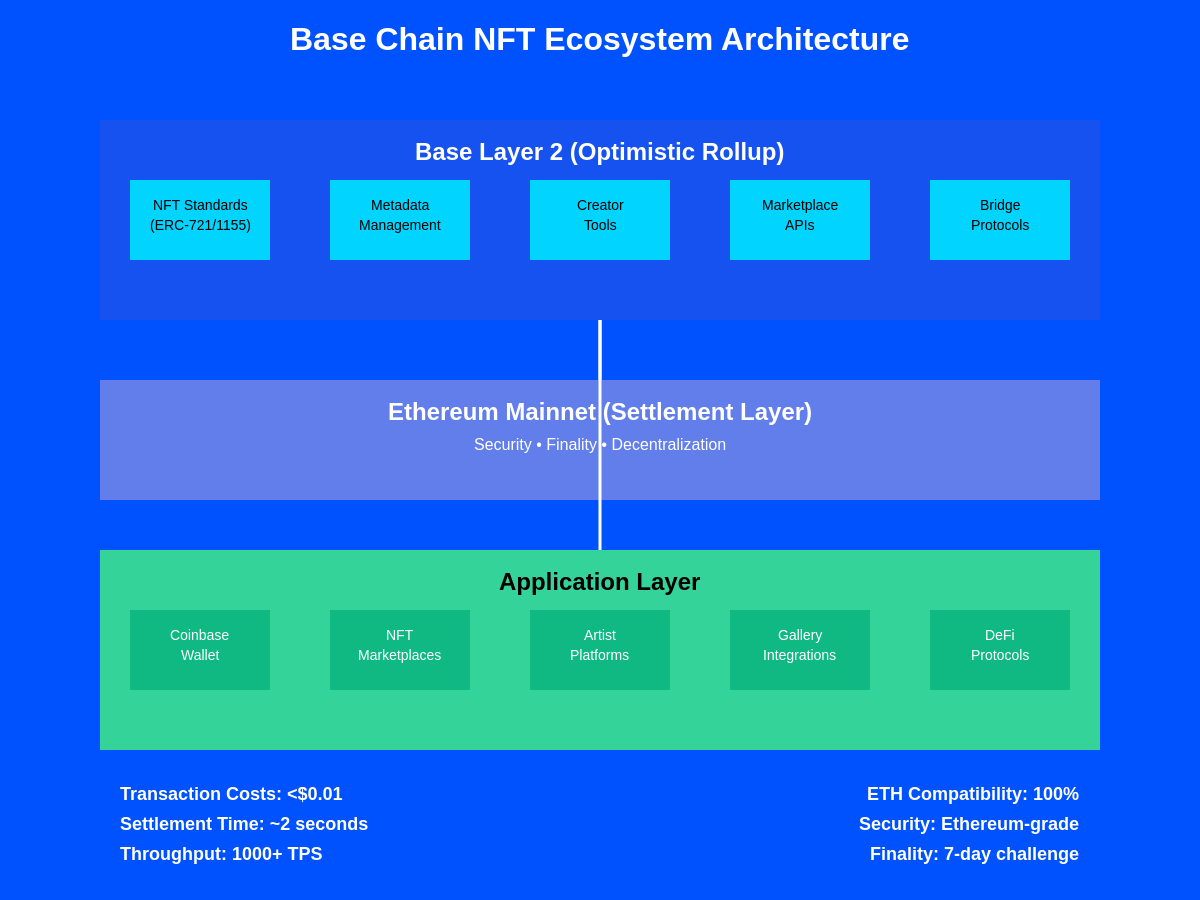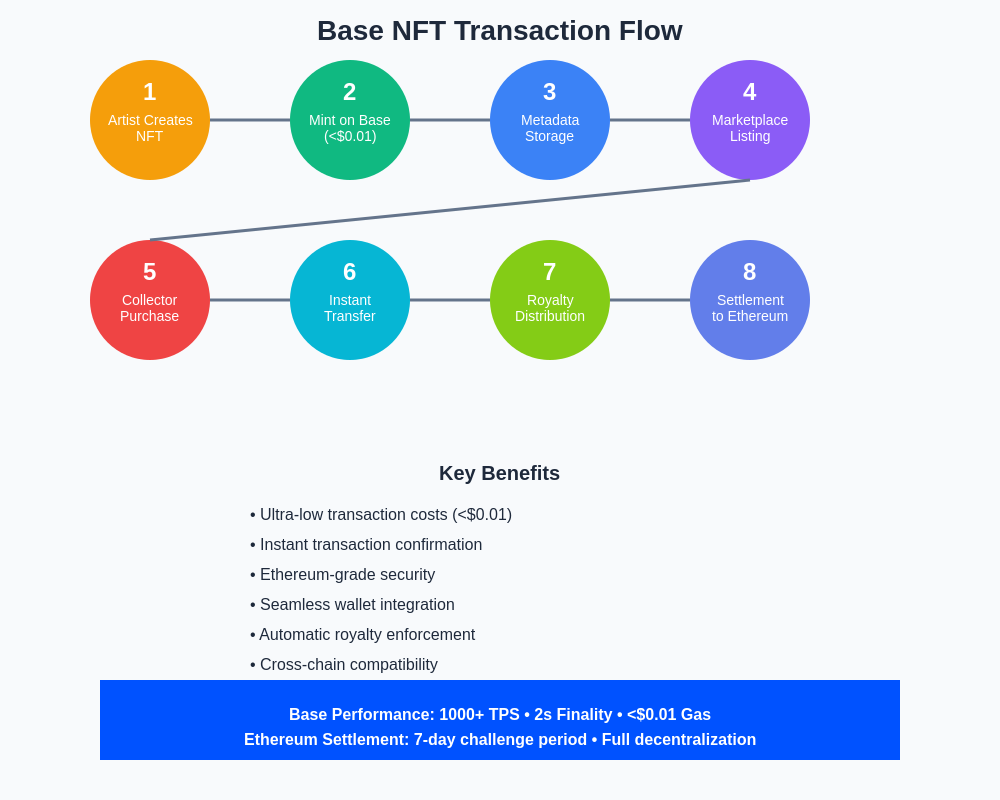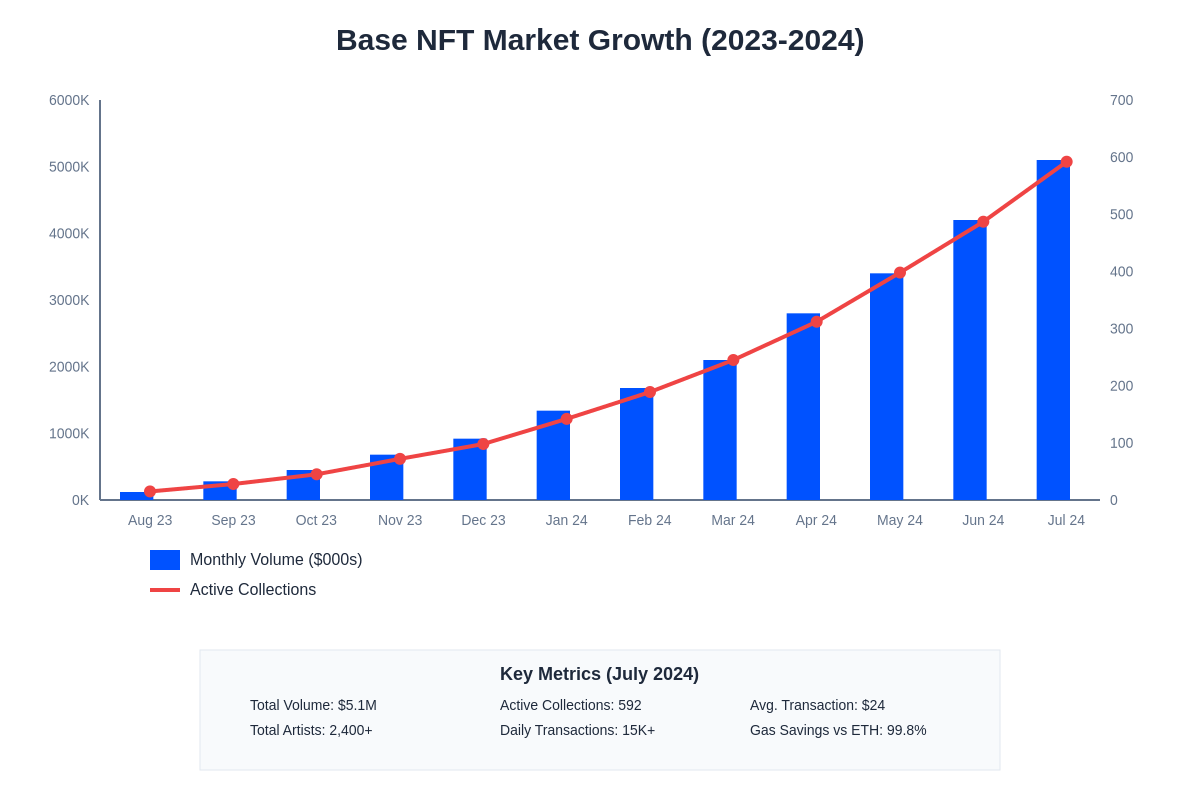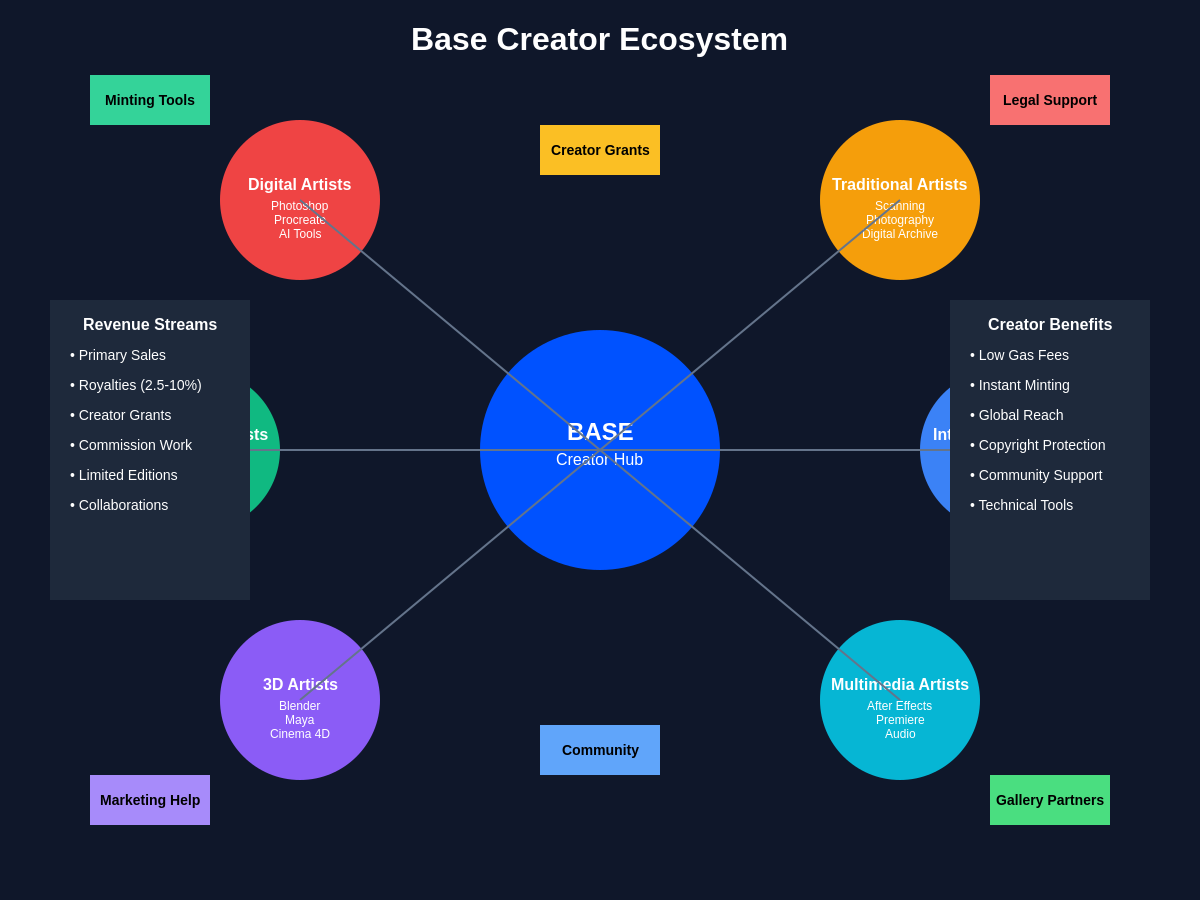The Emergence of Base as a Creative Platform
Advanced trading analysis tools and market data have become essential for understanding the rapid growth of Base Chain’s NFT ecosystem, which has emerged as one of the most significant developments in the intersection of traditional finance and digital art. Coinbase’s Layer 2 blockchain solution has transformed from a simple scaling technology into a comprehensive creative ecosystem that is redefining how artists, collectors, and institutions engage with non-fungible tokens in an environment optimized for mainstream adoption.
The Base blockchain represents a fundamental shift in how major financial institutions approach digital art and collectibles, leveraging Coinbase’s regulatory expertise and technical infrastructure to create an NFT ecosystem that addresses many of the barriers that have historically prevented mainstream adoption of blockchain-based art. This platform combines the security and decentralization of Ethereum with dramatically reduced transaction costs and improved user experience, creating an environment where artists can experiment with digital creativity without the financial constraints that have limited NFT accessibility on the Ethereum mainnet.
Base’s emergence as a creative platform reflects broader trends in the cryptocurrency industry toward practical applications that solve real-world problems rather than purely speculative investments. The platform’s focus on user experience, regulatory compliance, and institutional-grade security has attracted a diverse community of creators ranging from established traditional artists transitioning to digital mediums to native digital artists exploring new forms of blockchain-based creativity.

Layer 2 Technology and NFT Scalability
The technical architecture underlying Base’s NFT ecosystem represents a sophisticated implementation of Layer 2 scaling technology specifically optimized for digital art and collectibles, addressing the fundamental scalability challenges that have historically limited NFT market growth and accessibility. Base utilizes optimistic rollup technology to achieve dramatically reduced transaction costs while maintaining compatibility with Ethereum’s existing NFT standards and infrastructure, enabling seamless integration with established marketplaces and tooling.
Transaction costs on Base typically range from fractions of a cent to a few cents for NFT minting and trading operations, compared to the tens or hundreds of dollars often required for similar operations on Ethereum mainnet during periods of network congestion. This cost reduction has democratized NFT creation and trading, enabling artists to mint smaller collections, experiment with interactive art forms, and engage in frequent updates to dynamic NFT projects without prohibitive gas fees limiting their creative expression.
The scalability improvements provided by Base’s Layer 2 architecture extend beyond simple cost reduction to enable entirely new categories of NFT applications that were previously impractical on Ethereum mainnet. These include real-time interactive art that responds to market data, collaborative art projects involving thousands of participants, and gaming applications that require frequent on-chain interactions without substantial transaction costs for each user action.
Base’s settlement mechanism ensures that all NFT transactions ultimately benefit from Ethereum’s security guarantees while providing immediate finality for user interactions within the Layer 2 environment. This hybrid approach combines the best aspects of Ethereum’s proven security model with the performance characteristics necessary for mainstream consumer applications, creating a platform that satisfies both the security requirements of high-value digital art and the user experience expectations of mass market adoption.

Coinbase’s Strategic Vision for Digital Art
Coinbase’s entry into the NFT ecosystem through Base represents a carefully orchestrated strategy to bridge the gap between traditional art markets and blockchain-based digital creativity, leveraging the company’s regulatory expertise and mainstream user base to create new pathways for artist monetization and collector engagement. This strategic vision extends far beyond simple technical infrastructure to encompass comprehensive market development, artist support programs, and institutional adoption initiatives designed to establish Base as the preferred platform for serious digital art creation and collection.
The integration of Base NFTs with Coinbase’s existing financial services infrastructure creates unique opportunities for artists and collectors to seamlessly transition between traditional financial instruments and blockchain-based digital assets. This integration includes direct fiat on-ramps for NFT purchases, sophisticated portfolio management tools that treat digital art as a legitimate asset class, and compliance frameworks that enable institutional participation in digital art markets with the same regulatory confidence they expect from traditional financial products.
Coinbase’s approach to NFT market development emphasizes quality over quantity, implementing curation mechanisms and artist verification processes designed to elevate the overall standard of digital art on the platform while preventing the spam and low-quality content that has plagued other NFT marketplaces. This curatorial approach reflects the company’s understanding that sustainable NFT market growth requires building genuine value for both creators and collectors rather than simply facilitating speculative trading activity.
The company’s institutional relationships and regulatory standing provide Base NFT creators with access to collector bases and distribution channels that are typically unavailable to artists working on other blockchain platforms. These advantages include direct integration with traditional art galleries exploring digital exhibitions, partnerships with established auction houses beginning to offer blockchain-based art, and access to high-net-worth collectors who require the regulatory certainty and institutional oversight that Coinbase’s platform provides.
Technical Infrastructure and Developer Tools
The technical infrastructure supporting Base’s NFT ecosystem has been designed with a comprehensive understanding of the specific requirements for digital art creation, distribution, and preservation, incorporating advanced features for metadata management, media storage, and creator rights management that address many of the technical limitations that have constrained NFT development on other platforms. This infrastructure provides artists and developers with sophisticated tools for creating complex, interactive, and evolving digital art projects while maintaining the simplicity necessary for mainstream adoption.
Base’s NFT standards extend beyond basic ERC-721 and ERC-1155 implementations to include enhanced metadata frameworks that support complex attribution systems, royalty management, and provenance tracking throughout the entire lifecycle of digital art pieces. These enhanced standards enable artists to embed sophisticated licensing terms, collaborative attribution mechanisms, and dynamic pricing models directly into their NFT contracts, creating new possibilities for artist compensation and rights management in digital mediums.
Developer tools provided by the Base ecosystem include comprehensive SDKs for NFT creation and management, integration libraries for popular development frameworks, and specialized APIs for common NFT operations such as batch minting, metadata updates, and marketplace integration. These tools are designed to reduce the technical barriers for artists and art platforms seeking to build on Base while providing the flexibility necessary for innovative applications that push the boundaries of what is possible with blockchain-based digital art.
The platform’s approach to media storage addresses one of the most significant technical challenges in the NFT space by providing robust, decentralized storage solutions that ensure long-term accessibility of digital art assets while maintaining compatibility with existing NFT metadata standards. This storage infrastructure includes automatic redundancy, content addressing for immutable media references, and migration tools that protect against vendor lock-in while ensuring that digital art remains accessible regardless of changes in storage provider business models.
Market Dynamics and Trading Patterns
The trading dynamics within Base’s NFT ecosystem demonstrate sophisticated market behavior that reflects both the platform’s technical advantages and its unique position within the broader cryptocurrency landscape, with detailed market analysis available through advanced charting platforms showing distinct patterns in collector behavior, price formation, and liquidity provision that differentiate Base NFT markets from those on other blockchain platforms.
Transaction volume patterns on Base show significantly higher frequency trading compared to Ethereum mainnet NFT markets, with the reduced transaction costs enabling more frequent position adjustments, portfolio rebalancing, and experimental collecting behavior. This increased trading frequency has led to more efficient price discovery mechanisms and reduced bid-ask spreads for established digital art collections, creating market conditions that more closely resemble traditional art markets than the often illiquid and volatile conditions typical of mainnet NFT trading.
The composition of Base NFT collectors demonstrates a broader demographic diversity than traditional NFT platforms, with significant participation from users who previously found blockchain-based digital art inaccessible due to technical complexity or transaction cost barriers. This expanded collector base includes traditional art collectors exploring digital mediums, younger demographics seeking affordable entry points into art collection, and institutional participants attracted by Base’s regulatory clarity and technical reliability.
Price formation mechanisms within Base NFT markets show increased correlation with traditional art market dynamics, including factors such as artist reputation, artistic quality, historical significance, and cultural relevance, rather than the purely speculative dynamics that have often dominated NFT pricing on other platforms. This shift toward fundamentals-based pricing reflects the platform’s success in attracting serious collectors and creating sustainable market conditions for digital art appreciation.

Artist Onboarding and Creative Tools
Base’s approach to artist onboarding represents a comprehensive strategy for supporting creators throughout their transition to blockchain-based digital art, providing educational resources, technical support, and financial assistance designed to reduce barriers and accelerate the development of a vibrant creative community. This support infrastructure addresses the unique challenges faced by traditional artists exploring digital mediums while providing advanced tools for digitally native creators seeking to push the boundaries of blockchain-based artistic expression.
The platform’s creator education programs include comprehensive tutorials covering technical aspects of NFT creation, smart contract interaction, and metadata management, as well as business-focused content addressing pricing strategies, collector engagement, and rights management in digital art markets. These educational resources are continuously updated to reflect evolving best practices and new technical capabilities, ensuring that artists have access to current information for making informed decisions about their digital art careers.
Technical tools provided to artists include user-friendly minting interfaces that abstract complex blockchain interactions while providing advanced customization options for creators who require sophisticated contract functionality. These tools support various artistic mediums including static images, animated content, interactive experiences, and programmable art that evolves based on external data sources, enabling artists to explore creative possibilities that are unique to blockchain-based mediums.
Financial support mechanisms for emerging artists include reduced minting fees for verified creators, grants for experimental digital art projects, and revenue sharing programs that provide ongoing compensation for artists whose work contributes to platform growth and community development. These financial incentives are designed to create sustainable career paths for digital artists while encouraging innovation and experimentation in blockchain-based creative expression.

Institutional Adoption and Gallery Partnerships
The integration of Base NFTs into traditional art market infrastructure represents one of the most significant developments in the mainstream acceptance of blockchain-based digital art, with established galleries, auction houses, and cultural institutions beginning to incorporate Base-native digital art into their exhibition and sales programs. This institutional adoption reflects both the technical advantages of Base’s platform and the regulatory certainty provided by Coinbase’s compliance framework, creating new opportunities for artists to reach traditional art market participants.
Gallery partnerships with Base have evolved beyond simple digital art sales to include comprehensive programs for artist development, curatorial support, and market education designed to bridge the gap between traditional and digital art communities. These partnerships often include physical exhibition components that showcase digital art through advanced display technologies, creating hybrid experiences that appeal to both traditional art collectors and blockchain-native audiences.
Auction house integration with Base NFT markets has introduced professional auction services, expert curation, and sophisticated bidding mechanisms to blockchain-based digital art sales, bringing the expertise and credibility of established art market institutions to NFT transactions. These partnerships have resulted in record-breaking sales for Base-native digital art and have established pricing benchmarks that provide market validation for serious digital art creation.
Cultural institution adoption of Base NFTs includes museum acquisitions, educational programs, and research initiatives that explore the intersection of blockchain technology and artistic expression. These institutional relationships provide long-term validation for digital art as a legitimate artistic medium while creating preservation and archival frameworks that ensure the cultural significance of important digital art works is maintained for future generations.
Regulatory Compliance and Legal Framework
The regulatory framework governing Base NFTs represents a sophisticated approach to compliance that addresses many of the legal uncertainties that have constrained institutional participation in NFT markets, leveraging Coinbase’s extensive regulatory expertise to create clear guidelines for artists, collectors, and platforms operating within the Base ecosystem. This compliance framework provides certainty for participants while maintaining the innovative potential that makes blockchain-based digital art compelling for creators and collectors.
Securities law compliance within Base NFT markets includes clear guidelines for distinguishing between digital art collectibles and investment products, providing safe harbors for artistic expression while establishing requirements for projects that may constitute securities offerings. This regulatory clarity enables artists to focus on creative expression while providing collectors with confidence that their purchases comply with applicable securities laws.
Intellectual property protections within the Base framework include comprehensive mechanisms for establishing and transferring copyright, licensing rights, and attribution claims associated with digital art NFTs. These protections address many of the legal ambiguities that have surrounded NFT ownership rights while providing practical tools for artists to monetize their intellectual property in digital formats.
Anti-money laundering and know-your-customer compliance within Base NFT markets meets institutional standards for financial services while maintaining appropriate privacy protections for individual artists and collectors. This compliance framework enables traditional financial institutions to participate in Base NFT markets with confidence while protecting users from excessive surveillance or data collection.
Cross-Chain Interoperability and Bridges
Base’s approach to cross-chain functionality enables seamless integration with other blockchain ecosystems while maintaining the performance and cost advantages that define the platform’s value proposition for NFT creators and collectors. This interoperability infrastructure includes sophisticated bridging mechanisms that preserve NFT metadata, ownership history, and smart contract functionality across different blockchain environments, creating opportunities for artists to reach broader audiences without sacrificing the technical advantages of Base’s Layer 2 architecture.
The technical implementation of cross-chain NFT transfers addresses complex challenges related to metadata preservation, smart contract compatibility, and security verification across different blockchain architectures. Base’s bridging solutions maintain full compatibility with Ethereum mainnet while providing efficient pathways for interaction with other Layer 2 networks and alternative blockchain platforms, enabling artists to optimize their distribution strategies based on technical requirements and audience preferences.
Marketplace integration across multiple blockchain platforms enables Base NFT collectors to participate in cross-chain trading while maintaining custody of their assets within Base’s optimized environment. These integrations include automated arbitrage mechanisms, cross-chain price discovery, and unified portfolio management tools that provide comprehensive visibility into digital art holdings across multiple blockchain networks.
The security framework for cross-chain operations includes comprehensive audit processes, multi-signature verification requirements, and time-delayed transfers for high-value assets, ensuring that interoperability features do not compromise the security guarantees that make Base attractive for serious digital art collection and creation.
Economic Models and Creator Monetization
The economic framework underlying Base’s NFT ecosystem has been designed to optimize long-term sustainability for artists while creating attractive investment opportunities for collectors, incorporating sophisticated revenue sharing mechanisms, royalty management systems, and creator support programs that address many of the monetization challenges that have limited artist participation in blockchain-based digital art markets.
Primary market mechanisms within Base include flexible pricing models that accommodate various artistic approaches, from fixed-price releases to sophisticated auction formats that maximize price discovery for unique digital art pieces. These pricing mechanisms include Dutch auctions, English auctions, and reserve price systems that provide artists with tools for optimizing their revenue while creating engaging purchasing experiences for collectors.
Secondary market royalty systems ensure that artists continue to benefit from appreciation in the value of their work throughout its lifecycle, with smart contract enforcement of royalty payments and transparent tracking of all subsequent sales. These royalty mechanisms include graduated rates based on sale prices, artist-specified beneficiary distributions, and community fund contributions that support broader ecosystem development.
Creator grant programs provide direct financial support for experimental digital art projects, community building initiatives, and technical innovation that advances the state of blockchain-based artistic expression. These grants are funded through platform fees, community contributions, and strategic partnerships with traditional art market institutions seeking to support digital art development.
Future Roadmap and Technical Development
The technical roadmap for Base’s NFT ecosystem includes ambitious plans for advanced functionality that will further differentiate the platform from other blockchain-based digital art solutions, incorporating emerging technologies such as artificial intelligence integration, virtual reality support, and advanced interactivity frameworks that enable new forms of digital artistic expression previously impossible within blockchain environments.
Artificial intelligence integration within Base NFT creation tools will enable artists to incorporate machine learning models directly into their digital art pieces, creating works that evolve based on external data, user interaction, or predetermined algorithmic parameters. These AI-enabled NFTs represent a new category of digital art that leverages blockchain technology for provenance and ownership while utilizing artificial intelligence for dynamic content generation and audience engagement.
Virtual reality and metaverse integration capabilities will enable Base NFT artists to create immersive experiences that extend beyond traditional two-dimensional digital art into three-dimensional environments, architectural spaces, and interactive worlds that can be experienced through virtual reality platforms. These capabilities include specialized tools for 3D asset creation, spatial audio integration, and multi-user experience design that positions Base as a platform for cutting-edge digital art creation.
Advanced smart contract functionality planned for future releases includes programmable art that responds to market conditions, collaborative creation frameworks that enable multiple artists to contribute to evolving digital art pieces, and community governance mechanisms that allow collectors to participate in decisions about the future development of digital art projects they support.
Global Market Impact and Cultural Significance
The broader impact of Base’s NFT ecosystem extends beyond technical innovation to encompass significant cultural and economic implications for how digital art is created, distributed, and valued within global creative communities. The platform’s success in reducing barriers to blockchain-based digital art has enabled artists from diverse geographic and economic backgrounds to participate in global digital art markets, creating new opportunities for cultural exchange and artistic collaboration across traditional boundaries.
Economic democratization through Base’s low-cost NFT infrastructure has enabled artists in developing economies to access global collector markets without the prohibitive transaction costs that previously limited their participation in blockchain-based digital art sales. This democratization has resulted in increased diversity within digital art markets and has provided new revenue streams for artists who previously lacked access to international art market infrastructure.
Cultural preservation opportunities within Base’s NFT framework include initiatives to digitize and tokenize traditional art forms, cultural artifacts, and historical documents, creating permanent blockchain-based records that ensure preservation while enabling new forms of cultural sharing and education. These preservation projects often involve partnerships with cultural institutions, indigenous communities, and historical societies seeking to leverage blockchain technology for cultural heritage protection.
The platform’s influence on contemporary art discourse includes academic recognition of blockchain-based digital art as a legitimate artistic medium, integration of digital art into traditional art education curricula, and the development of new critical frameworks for evaluating and interpreting art that incorporates blockchain technology as an integral component of artistic expression.
Community Building and Social Features
Base’s approach to community development within its NFT ecosystem emphasizes the creation of meaningful connections between artists and collectors while fostering collaborative relationships that extend beyond simple marketplace transactions. The platform’s social features include artist profiles, collector galleries, and community discussion spaces that enable deeper engagement with digital art and the creators who produce it.
Artist community support includes mentorship programs that connect established creators with emerging artists, collaborative project frameworks that enable multiple artists to work together on complex digital art initiatives, and peer review systems that provide constructive feedback and quality assurance for new digital art releases. These community support mechanisms create educational opportunities and professional development pathways that strengthen the overall quality and sustainability of the Base NFT ecosystem.
Collector engagement features include sophisticated portfolio management tools, social collecting features that enable friends and colleagues to share collection insights and recommendations, and educational resources that help collectors develop expertise in evaluating and appreciating blockchain-based digital art. These features are designed to create more informed and engaged collector communities that provide sustainable demand for high-quality digital art creation.
Cross-platform community integration enables Base NFT enthusiasts to maintain connections with broader digital art communities while leveraging the specific advantages of Base’s technical infrastructure. These integrations include social media connectivity, cross-platform collection displays, and integration with virtual galleries and metaverse platforms that showcase Base NFT collections in immersive environments.
Security Framework and Asset Protection
The security infrastructure protecting Base NFT assets incorporates multiple layers of protection designed to address the unique risks associated with digital art ownership while maintaining the user experience advantages that define the platform’s value proposition. This comprehensive security framework includes technical safeguards, user education programs, and recovery mechanisms that provide confidence for artists and collectors engaging with valuable digital art assets.
Technical security measures include advanced smart contract auditing processes, multi-signature wallet integration, and sophisticated fraud detection systems that monitor trading patterns for suspicious activity. These technical protections are complemented by user education programs that provide practical guidance for secure NFT storage, trading practices, and recovery procedures in case of account compromise or technical issues.
Insurance frameworks for Base NFT assets include partnerships with specialized insurers that understand the unique characteristics of digital art ownership and the specific risks associated with blockchain-based asset custody. These insurance products provide protection against smart contract vulnerabilities, platform failures, and user error while maintaining competitive premiums that make insurance accessible for artists and collectors with modest digital art holdings.
Asset recovery mechanisms include sophisticated backup systems, multi-device authentication options, and social recovery features that enable trusted contacts to assist with account recovery in emergency situations. These recovery systems balance security with accessibility, ensuring that artists and collectors can regain access to their digital art assets while maintaining protection against unauthorized access attempts.
Environmental Sustainability and Carbon Impact
Base’s environmental approach to NFT operations addresses growing concerns about the carbon footprint of blockchain-based digital art while maintaining the technical performance characteristics that make the platform attractive for creators and collectors. The platform’s Layer 2 architecture inherently provides significant energy efficiency improvements compared to Ethereum mainnet operations, with further optimizations planned to minimize environmental impact.
Energy consumption metrics for Base NFT operations demonstrate dramatic improvements over traditional blockchain NFT platforms, with individual NFT transactions consuming only a fraction of the energy required for similar operations on proof-of-work blockchain networks. These efficiency improvements enable environmentally conscious artists and collectors to engage with blockchain-based digital art without compromising their sustainability commitments.
Carbon offset programs integrated into Base’s NFT marketplace provide automatic carbon neutrality for digital art transactions, with offset costs integrated into platform fees and funded through partnerships with verified carbon credit providers. These offset programs are transparent and auditable, providing users with detailed information about the environmental impact of their digital art activities and the specific offset measures that achieve carbon neutrality.
Renewable energy initiatives include partnerships with renewable energy providers that ensure Base’s technical infrastructure operates on sustainable energy sources, creating a comprehensive approach to environmental responsibility that extends beyond simple carbon offsetting to include fundamental infrastructure sustainability.
Disclaimer: This article is for informational purposes only and does not constitute financial advice. Cryptocurrency investments, including NFTs, carry inherent risks and potential for loss. Past performance does not guarantee future results. Always conduct your own research and consult with qualified financial advisors before making investment decisions. The regulatory landscape for digital assets continues to evolve, and changes in regulation could impact the value and utility of NFT investments.